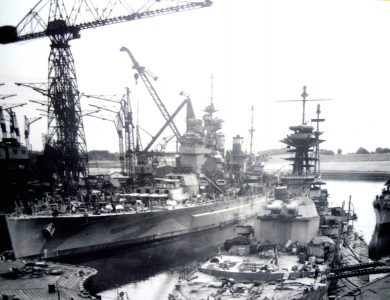
Servia, built by J. & G. Thomson at Clydebank in 1881, was the first ocean liner to be built of steel instead of iron, and the first Cunard ship to have electric lighting — copyright photo West Dunbartonshire Council
Robert Cleary welcomes Clydebank Museum’s display of artefacts and pictures evoking Clydeside’s glorious past as ‘shipbuilder to the world’.
Visitors to this new exhibition at Clydebank Museum and Art Gallery are taken on a historical tour of some of the famous and less famous shipyards which provided employment for many years on the north bank of the River Clyde.
‘When the Clyde Ruled the Waves’, which runs until October 29, has been attractively put together in four galleries by Andrew Graham, Collections Officer of West Dunbartonshire Libraries and Cultural Services. An introductory panel explains the historical context and importance of shipbuilding to the local economy, particularly in Dumbarton and Clydebank.

Model and painting: the cross-channel steamer Alma, built by J. & G. Thomson at Clydebank in 1894 — copyright photo West Dunbartonshire Council
Further colourful panels are devoted to shipyards in the Leven and along the north bank of the Clyde. The first of these describes the Leven yard of McMillan & Son which started building sailing ships in 1834 and at its height employed 1,000 men. It developed a reputation for producing reliable and fast ships with double-bottoms and machine-riveted hulls. The yard closed in 1932.
Considerable space is given over to the most famous Dumbarton yard — William Denny & Sons, shipbuilder and engineer extraordinaire. The first William Denny commenced operations in 1814 and five of his sons followed him into the business. Many famous cross-channel ships were built at Denny’s, which was always at the forefront of development and innovation.
The lasting monument to the firm’s achievements is the Denny Model Tank, opened in 1883 and the first of its kind in the world. It can still be visited today, being part of the Scottish Maritime Museum.
Denny was also closely associated with the Irrawaddy Flotilla Company, and near the end of the yard’s existence experimented with hovercraft design. Sadly the yard was to close in 1963 as it did not have the space to build the larger type of ships being ordered at that time.
Travelling east up the Clyde we come to Scott’s of Bowling, which flourished from 1851 until 1979. Scott’s built mainly smaller vessels, being particularly renowned for producing tugs. The exhibition also features the small yard of Napier & Miller at Old Kilpatrick (1907-31), builder of the Clyde paddler Eagle III, and William Beardmore and Company at Dalmuir (1905-30), known chiefly as a builder of naval ships.
Perhaps the best-known was John Brown & Company at Clydebank (1899-1968), successor to J. & G. Thomson (1872-97), builder of the 1881 Claymore, the 1892 Glen Sannox and other notable steamers. The story of John Brown’s is given in some detail, with particular reference to the iconic Cunard ‘Queens’. There is also information on the Titan Crane and the famous 1971 Upper Clyde Shipbuilders ‘work-in’, when the workforce — led by Jimmy Reid and other young shop stewards — took action to prove the yard’s long-term viability in the face of plans to liquidate it.
The last gallery contains information about the famous Dumbarton-built tea clipper Cutty Sark, the battlecruiser HMS Hood and the Polish destroyer ORP Piorun which, lying at Brown’s yard, gallantly fought back at the German planes attacking Clydebank during the Blitz in 1941.
The narrative history of the yards is enhanced by a number of fine portraits of important figures at the helm of the yards and by some evocative prints by Frank Mason and Sir Muirhead Bone of scenes illustrating the yards at work.
There are also photographs of the workers who put the ships together. A particularly nice touch is a picture of the ladies who polished furniture for the splendid saloons of the passenger ships built at John Brown’s.
Smaller displays include artefacts from ship launches and a fragment of hull recovered from the liner Queen Elizabeth, which sank in Hong Kong Harbour in 1972 and was later dismantled for scrap.
Finally there are models of Cutty Sark, the transatlantic liner Servia of 1881, the London & South Western Railway’s Alma of 1894, the battleship HMS Duke of York (1940) and ORP Piorun.
Despite limiting itself to yards in Dunbartonshire, ‘When the Clyde Ruled the Waves’ succeeds in summarising the qualities that made the entire Clyde shipbuilding industry world-famous. As such the display is an excellent evocation of a vanished era, and well worth a visit.
‘When the Clyde Ruled the Waves’ runs until October 29 at Clydebank Museum and Art Gallery (within Clydebank Town Hall). Opening times are Monday to Saturday 10am to 4.30pm. Admission is free.














